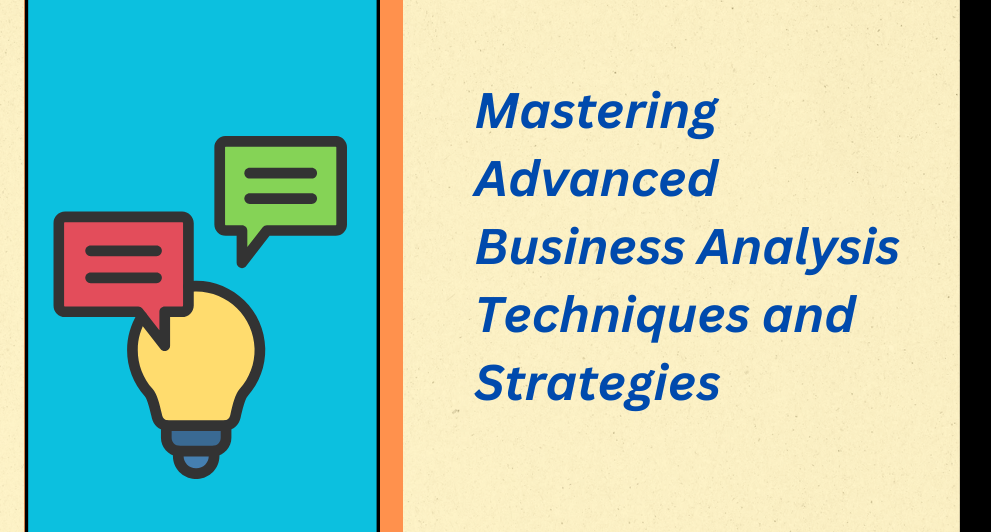Mastering Advanced Business Analysis Techniques and Strategies
 khushnuma
khushnuma
Introduction: The Importance of Advanced Business Analysis Techniques
In today’s competitive market, the ability to analyze data and develop effective strategies is essential for business success. Advanced business analysis empowers organizations to understand market dynamics, improve efficiency, and make data-driven decisions. This article explores advanced techniques and strategies that can elevate business analysis to the next level, driving growth and sustainable success.
Understanding Advanced Business Analysis
Business analysis focuses on evaluating a company’s needs and identifying solutions. While basic business analysis typically addresses immediate needs, advanced business analysis takes a deeper, more strategic approach. This involves using tools like predictive analytics, data modeling, and forecasting to anticipate future trends, identify business challenges, and optimize operations.
Key Advanced Business Analysis Techniques
1. Predictive Analytics: Unlocking Future Insights
Predictive analytics uses historical data and statistical algorithms to forecast future events. This technique helps businesses predict customer behavior, market trends, and demand fluctuations. By anticipating future needs, businesses can optimize inventory, improve resource allocation, and plan for changing market conditions.
Example: Retailers use predictive analytics to forecast inventory levels, reducing the risk of overstocking or stockouts, thus ensuring customer satisfaction and optimizing supply chain operations.
2. Data Visualization: Transforming Data Into Insights
Data visualization is the process of presenting complex data in a visual format, such as charts, graphs, or dashboards. Tools like Tableau, Google Data Studio, and Power BI help analysts turn raw data into meaningful insights, making it easier to understand and communicate findings.
Why It Matters: Clear data visuals help businesses spot trends, identify issues, and make faster, informed decisions. It also allows stakeholders to interpret data more efficiently and respond to market changes promptly.
3. Business Intelligence (BI): Turning Data into Strategic Insights
Business Intelligence (BI) tools aggregate and analyze large datasets to provide actionable insights. Techniques like data mining, sentiment analysis, and trend analysis fall under BI. These methods help identify hidden patterns and emerging trends that could shape business strategies.
Example: Companies use BI to monitor customer sentiment, track industry trends, and analyze competitor behavior, gaining a competitive advantage in their market.
4. Process Optimization and Reengineering
Process optimization seeks to eliminate inefficiencies in business operations, while process reengineering involves redesigning workflows to enhance performance. These strategies ensure businesses reduce costs, improve product quality, and enhance customer satisfaction.
Example: By streamlining operations, a company may reduce production time, resulting in cost savings and faster delivery to customers.
5. Advanced Forecasting Methods: Planning for the Future
Advanced forecasting methods predict future trends and outcomes by analyzing current and historical data. Techniques like time series analysis, Monte Carlo simulations, and causal forecasting provide more accurate predictions for demand, sales, and market changes.
Example: Companies use forecasting to predict future sales, adjust marketing strategies, and optimize production cycles, helping to stay ahead of competitors.
Strategic Business Analysis Frameworks
Frameworks are essential tools for guiding advanced business analysis and ensuring structured decision-making. Here are three widely-used frameworks:
1. SWOT Analysis: Understanding Strengths and Weaknesses
A SWOT analysis (Strengths, Weaknesses, Opportunities, and Threats) helps businesses assess both internal and external factors. This analysis provides insight into strategic opportunities and potential challenges.
2. PESTLE Analysis: Understanding External Influences
The PESTLE analysis (Political, Economic, Social, Technological, Legal, and Environmental) framework helps businesses evaluate macroeconomic factors. By considering these external influences, companies can anticipate risks and identify emerging trends.
3. Porter’s Five Forces: Analyzing Market Competition
Porter’s Five Forces framework evaluates the competitive forces within an industry: supplier power, buyer power, threat of substitutes, the threat of new entrants, and competitive rivalry. This helps businesses understand the market landscape and identify opportunities for differentiation.
Key Strategies for Business Analysis Success
To fully leverage advanced business analysis, businesses should adopt the following strategies:
1. Data-Driven Decision-Making: Let Data Guide You
Building a data-driven culture means using objective data to make decisions rather than relying on intuition. By focusing on analytics, businesses can make smarter decisions that lead to improved performance and profitability.
2. Continuous Learning and Training: Stay Ahead of the Curve
Business analysis tools and techniques are constantly evolving. Professionals must invest in continuous learning to stay updated on the latest trends, technologies, and methodologies.
3. Collaboration and Cross-Functional Teams: Harness Collective Expertise
Advanced business analysis often requires input from multiple departments, including marketing, finance, and IT. Cross-functional collaboration ensures that all perspectives are considered when analyzing data and implementing strategies.
4. Automation and AI Integration: Enhance Efficiency and Insights
Incorporating automation and artificial intelligence (AI) into the analysis process can increase efficiency and unlock deeper insights. AI helps analyze vast amounts of data quickly, uncovering patterns that may not be immediately visible to human analysts.
Conclusion: Driving Business Success with Advanced Analysis
Mastering advanced business analysis techniques is crucial for any organization looking to stay competitive. From predictive analytics and data visualization to process optimization and business intelligence, these strategies enable businesses to make more informed decisions, optimize performance, and plan for future growth. By embracing structured frameworks like SWOT, PESTLE, and Porter’s Five Forces, and adopting data-driven decision-making, companies can enhance their business analysis capabilities.
If you're looking to sharpen your skills, consider enrolling in a Business Analyst course in Delhi, Noida, Lucknow, Nagpur, and other cities in India. Such courses provide comprehensive training on the latest techniques and strategies in business analysis.
Subscribe to my newsletter
Read articles from khushnuma directly inside your inbox. Subscribe to the newsletter, and don't miss out.
Written by

khushnuma
khushnuma
I am a Digital Marketer and SEO Specialist; I enjoy technical and non-technical activity. I enjoy learning something new. My passion and urge to gain new insights into lifestyle,